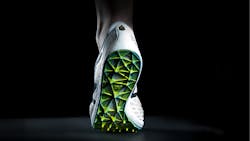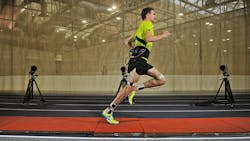3D Printing Builds Custom Track Shoes
Engineers and shoe designers at New Balance Athletic Shoes Inc., Boston, are using 3D printing to make shoes for elite runners (professionals and Olympians) in hopes of improving their performance. The company uses an EOSINT 395 3D printer from EOS to custom-build spike plates, the bottom part of the shoe that contains a pattern of spikes to give runners more traction as they run. The machine creates parts out of plastic using a proprietary nylon powder and laser sintering.
The first step in the process is to collect biomechanical data on a specific runner using several different tools. Video capture, for example, lets researchers create a three-dimensional force-vector diagram of the runner's feet as they hit the surface of a force plate while running. Pressure sensors inside the runner’s shoe provide pressure data as the runner’s feet hit the ground and lets the researchers determine how the feet are interacting with the shoe. High-pressure values, for example, indicate an area of the foot that is important during that phase of the foot strike.
Armed with this data and some parametric modeling software, New Balance designers calculate the best spike pattern, how large the spikes should be, and how they should be oriented. After the final design is cleaned up, it gets converted to an .stl file and sent to the printer to build the spike plate. The printer lets them build spike plates that could not be economically made using traditional manufacturing processes. Designers usually provide runners with several spike plates to test and then vary the fit, stiffness, and design depending on the length of the race the runners are facing, along with their personal preferences. Currently, the 3D printer makes four spike plates at a time in five to six hours.
One Olympic runner, Kim Conley, wore her custom spike plates when she set personal records in 3,000- and 5,000-meter races, and during her best international performance--the 2013 World Track Championships. She credits her success to the shoes’ improved traction while reliving pressure on the outside of her feet. The shoes are also 5% lighter than traditionally made track shoes. For competitive runners, even a small weight reduction can make significant changes.
The goal at New Balance is to refine the 3D-printing process so that the company can offer custom-built spike plates or tread patterns to everyday consumer-athletes and possible expand to shoes for sports other than running. However, the repetitive foot motions used in running don’t carry over to other sports in which participants quickly change directions, pivot, back-pedal, or shuffle side to side. These motions would need to be closely studied to determine what performer data needed to be collected and how to analyze it.

